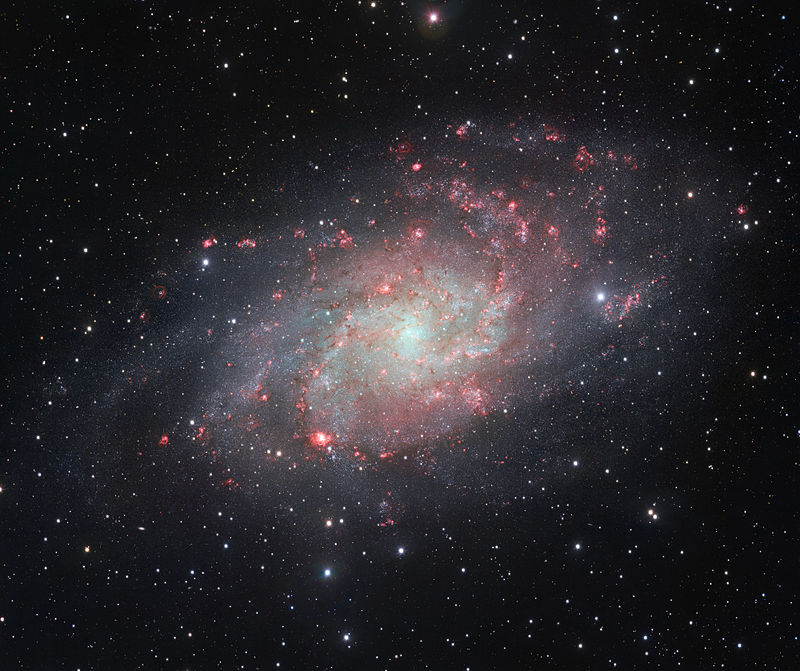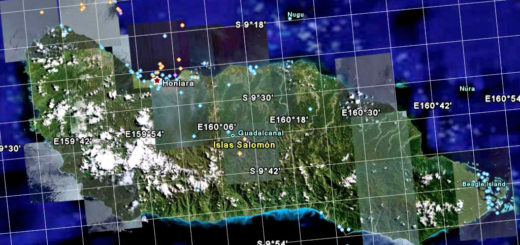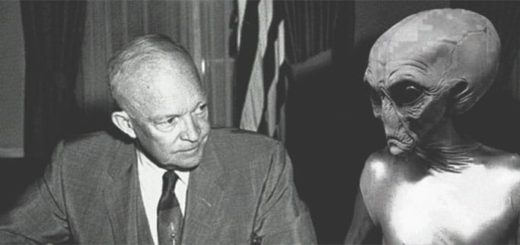Triangulum: 2nd-Closest Large Spiral Galaxy

Say hello to the much-photographed Triangulum galaxy – aka Messier 33 – a face-on pinwheel of swarming suns and the second-nearest spiral galaxy to our Milky Way. This galaxy is only about 2.7 million light-years away. It’s huge, with a diameter about half that of our Milky Way. But it’s turned face on to us and thus has a low surface brightness in our sky. Although theoretically visible to the unaided eye under dark sky conditions, it’s still not easy to spot in binoculars or even a telescope. Keep reading to learn more about this nearby, face-on, very beautiful spiral galaxy.
EarthSky lunar calendars are cool! They make great gifts. Order now. Going fast!
Constellation Triangulum. Notice its relationship to the constellation Andromeda and especially the star Mirach in Andromeda. Via astronomy.net
Constellation Triangulum. Notice its relationship to the constellation Andromeda and the star Mirach in Andromeda. The Andromeda galaxy is marked as M31. Via astronomy.net.
Via ESO Public Outreach
Here’s the star Mirach in Andromeda again. Notice that the Triangulum galaxy (M33) is about equidistant from this star as the Andromeda galaxy (M31). In other words, once you find Mirach and the Andromeda galaxy, a line between them will point, more or less, to the Triangulum galaxy. Via ESO Public Outreach.
How to find the Triangulum galaxy. Have you ever seen the Andromeda galaxy (Messier 31), closest spiral galaxy to our Milky Way? If not, try finding the Andromeda galaxy before you take on the Triangulum galaxy. Here are two ways to find the Andromeda galaxy:
Use constellation Cassiopeia to find Andromeda galaxy
Use Great Square of Pegasus to find Andromeda Galaxy
The Andromeda galaxy shines eight to nine times more brightly than the Triangulum galaxy, which is the most distant object that you can easily see with the unaided eye. Fortunately, the Triangulum and Andromeda galaxies are a relatively close 15 degrees apart (for reference, a fist-width at an arm length approximates 10 degrees).
Star-hop to the Andromeda galaxy to orient yourself to the Triangulum galaxy. As seen on the sky chart, the star Mirach stands about midway between the two galaxies. Once you find Mirach and the Andromeda galaxy, you can draw a line between them to point in the general direction of the Triangulum galaxy.
Now for a word of warning: even if you’re staring right at the Triangulum galaxy, it’s still possible to miss it. You won’t see the galaxy’s stars at all. Sometimes, this galaxy looks almost transparent, like a water spot on a window. The small blob in your binocular field might resemble an unwashed spot on an otherwise clean window. If you’ve never seen this deep-sky object before, it’s hard to know what to look for.
Once you finally spot the Triangulum galaxy, you may wonder how you overlooked it so many times before.
Artist’s illustration of our Local Group via Chandra X-Ray Observatory.
Artist’s concept of our Local Group via Chandra X-Ray Observatory.
Science of the Triangulum galaxy. The Triangulum galaxy is located at a distance of about 2.7 million light-years from our Milky Way. It’s a spiral galaxy, whose face-on orientation has given it the nickname Pinwheel Galaxy (another face-on spiral, Messier 101, also has this nickname).
The Triangulum galaxy is the third-largest member of our Local Group of galaxies. Our Local Group consists of several dozen galaxies; our Milky Way, the Andromeda galaxy and the Triangulum galaxy are the largest members.
After the Milky Way and Andromeda galaxies, the Triangulum galaxy ranks as the third-largest Local Group member. Its diameter is about 50,000 light-years, or about one-half that of our Milky Way. It’s thought to contain some 40 billion stars, in contrast to 400 billion for the Milky Way, and a trillion (1,000 billion) stars for Andromeda.
In 2004, astronomers found evidence for a clumpy stream of hydrogen gas linking the Triangulum galaxy with the nearby Andromeda galaxy. A year later, astronomers were able to estimate the proper motion – or sideways motion on our sky’s dome – of the Triangulum galaxy for the first time. They found that this galaxy is moving towards the Andromeda galaxy. Afterwards, some astronomers suggested the Triangulum galaxy might be a satellite of the Andromeda galaxy. In other words, over a timescale so vast we haven’t yet comprehended it, the Triangulum galaxy might orbit around the Andromeda galaxy.
It’s well known that the Andromeda galaxy is moving toward our Milky Way and that a collision between the two galaxies will occur some 4 billion years from now. Meanwhile, the fate of the Triangulum Galaxy isn’t known for certain. It might someday be torn apart and absorbed by the Andromeda galaxy. It might participate in the collision between the Milky Way and Andromeda galaxies.
Two other possibilities are a collision with the Milky Way before Andromeda arrives or an ejection from the Local Group.
It’s safe to say that the fate of these great galaxies is beyond human knowledge at this time!
Enjoying EarthSky? Sign up for our free daily newsletter today!
Bottom line: The Triangulum galaxy is the second-closest large spiral galaxy at 2.7 million light-years away. It’s turned face-on to us and so appears faint in our sky.



 Creators of mankind
Creators of mankind Description of “Tall white aliens”
Description of “Tall white aliens” Where they came from?
Where they came from? About hostile civilizations
About hostile civilizations The war for the Earth
The war for the Earth “Tall white aliens” about eternal life
“Tall white aliens” about eternal life Video: “Nordic aliens”
Video: “Nordic aliens” Aliens
Aliens Alien encounters
Alien encounters The aliens base
The aliens base UFO
UFO Technology UFO
Technology UFO Underground civilization
Underground civilization Ancient alien artifacts
Ancient alien artifacts Military and UFO
Military and UFO Mysteries and hypotheses
Mysteries and hypotheses Scientific facts
Scientific facts


















